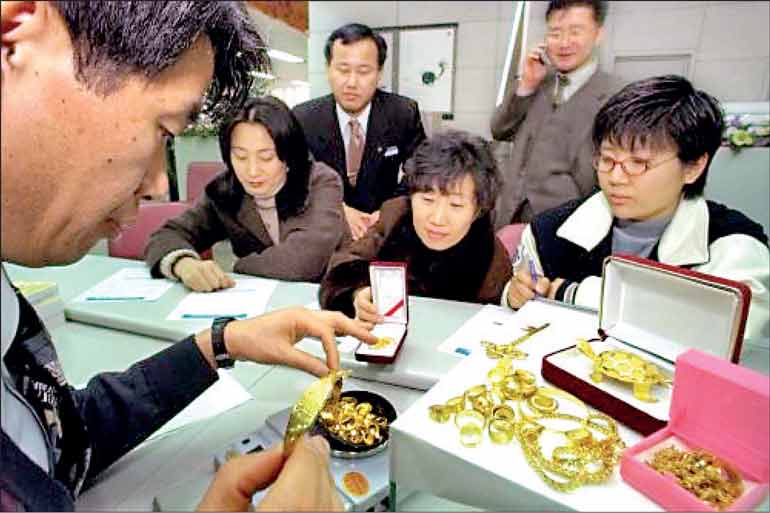Saturday Apr 19, 2025
Saturday Apr 19, 2025
Friday, 7 July 2023 00:02 - - {{hitsCtrl.values.hits}}

It was this gold that came to the rescue of South Korea in 1998
 Moving alongside the Han River in Korea and listening to the story of KIST moved me to write about the Miracle on the Han River to Daily FT on 16 October 2018 (https://www.ft.lk/columns/Miracle-on-the-Han-River-Can-Kelani-emulate/4-664474). I thought that story was quite inspirational and was pushing for the deployment of science and technology in the same way for Sri Lanka. Needless to say, such ideas even though they are evidence-based find little or no chance of getting attention in Sri Lanka especially if you are writing or voicing from within.
Moving alongside the Han River in Korea and listening to the story of KIST moved me to write about the Miracle on the Han River to Daily FT on 16 October 2018 (https://www.ft.lk/columns/Miracle-on-the-Han-River-Can-Kelani-emulate/4-664474). I thought that story was quite inspirational and was pushing for the deployment of science and technology in the same way for Sri Lanka. Needless to say, such ideas even though they are evidence-based find little or no chance of getting attention in Sri Lanka especially if you are writing or voicing from within.
Anyway, discussions today in Sri Lanka are ripe on how to make ends meet, and is a non-stop activity in some quarters. Immersed in this economic hotspot which had been declared bankrupt, my mind was reminded of another narrative on South Korea. My first encounter here was with the story written by Frank Holmes of US Global Investors in 2016 which led me to dig deeper.
South Korea had been building a solid reputation and cannot be argued against if one took that country as a textbook example of a reversal of economic fortunes and then demonstrating resilience and fortitude. Well, that was till 1997. The Asian economic crisis rolled into South Korea in the summer of 1997 and the economic foundations were shattered. I believe we remember that Sri Lanka was not that affected by the Asian financial crisis of the day. However, Sri Lanka never had such an economic structure and still is not. Highly leveraged companies quickly fell prey in South Korea. From that time, South Korea experienced the failure of companies, foreign investments were drained out, and then the consequent loss of jobs and livelihoods.
All these happened quite quickly and South Korea was not prepared for that. South Korea perhaps after weighing options went to the IMF and sought help. IMF was quite ready and the loan facility extended was $ 58 billion. I believe this was one big record loan at the time and perhaps even to date. The loan also had its associated share of conditions and that is the usual modus operandi anyway. Reasoning out conditions is that the lender cannot just pour in money to a country that they believe has structural weaknesses. Now these must-dos by the South Koreans as imposed by the IMF created in turn the IMF crisis as it was known. Just to put this narrative in perspective, the Sri Lankan issue is around an overall debt of $ 84 billion with an IMF loan expectation of about $ 3 billion. In the midst of this, the South Korean Government did something different. They raised an appeal to the masses.
The writeups subsequently indicate that this national campaign which was launched on 5 January, 1998 has been considered by far the best show of patriotism and self-sacrifice the world has ever witnessed. Really a significant claim and this is based on requesting gold from the populace and meeting the debt burden – the burden of becoming indebted to an international agency in the long term. We all are quite aware when you repay loans you pay the interest mostly and tiny amounts of the principal and finally, we all realise how much really, we end up paying in the end. Of course, you must acknowledge that you brought yourself to this position of weakness and that principal aspect cannot be delegated to anyone else.
Perhaps as you ride into economic danger you may have been reckless but response to succeed requires one to be really smart as well. Not many are equal to that task with most perhaps getting ensnared further. Sri Lanka is not in that second phase and it is perhaps a little too early to pass judgment. Most certainly we are not doing things in the way South Korea did at the time perhaps can be stated at this stage with some certainty. We must also remember that the economy still is more or less similar to the situation during the Asian economic crisis as not much had exactly changed in the complexity of the Sri Lankan economy as seen if one refers to Harvard’s Atlas of Economic complexity. While the simplicity allowed us to ride through relatively unscathed in 1997 the lack of diversity and variety is affecting us significantly during this self-made crisis.
The state of South Korea was aware of the value of the possession of gold in their households. The story indicates that the Government estimate was $ 20 billion worth of gold. The appeal of the state (via a bank and TV station coming together) was based on this knowledge and the appeal was direct and clear. Again, putting that situation in our perspective, I do not get an answer and I am sure all of you readers will agree. Of course, this much gold does not exist as mini-ingots inside households but exists as jewellery for various types of simple trinkets. Maybe some have gold medals having duly earned them the hard way and individually those medals matter a lot. The state knew that they had a task of gold recycling ahead as well if they succeed in the first call.
 The appeal by the state was for the nation to think beyond self. The power of gold in any economic condition is well understood and this characteristic of gold has withstood the test of time. Families are quite aware of their gold possessions as a solid form of financial security. In Sri Lanka when we see the places for pawning jewellery and the subsequent advertisements – on paper and even on lamp posts – with telephone numbers for support against losing them there is a whole economic sub-system running around gold. At the time the South Korean government was asking their citizens to give away their personal long-term financial securities – a national sacrificial movement. It was this gold that came to the rescue of South Korea in 1998. The call was really met with a significant positive response.
The appeal by the state was for the nation to think beyond self. The power of gold in any economic condition is well understood and this characteristic of gold has withstood the test of time. Families are quite aware of their gold possessions as a solid form of financial security. In Sri Lanka when we see the places for pawning jewellery and the subsequent advertisements – on paper and even on lamp posts – with telephone numbers for support against losing them there is a whole economic sub-system running around gold. At the time the South Korean government was asking their citizens to give away their personal long-term financial securities – a national sacrificial movement. It was this gold that came to the rescue of South Korea in 1998. The call was really met with a significant positive response.
Koreans queued to save the country from a debt trap. Korean society during the phase of becoming the miracle of the Han River had messages on science and technology even on a box of matches! They were told that S&T matters. The message on this occasion was ‘Let’s overcome the foreign currency crisis by collecting gold’. Yellow ribbons with this message could be found pinned to persons’ shirts. South Korean sports stars handed over their gold medals. Rich and the poor, the young and the old, all were seen donating and some selling. They knew that they will only have memories of their valuables subsequently. Yet they shouldered the responsibilities as citizens when the national call was made.
Historical evidence gives that about 3.5 million people contributed. On a per capita basis apparently, 65 grams of the yellow metal had been given to the state. The collection in two months had been 227 MT of gold. All the proceedings ended up being melted into ingots and the final destination of these ingots was the IMF. Now this perhaps was an awakening of the national psyche as well and one should understand that this alone cannot and did not resolve the debt burden. However, the response from all parts of the country had been to be part of the solution and with the head held high. $ 58 billion was paid in full by South Korea by August 2001. This was achieved three years ahead of schedule.
Are any lessons for Sri Lanka? That gold is useful we all know. Do we have an idea how much value in gold we have in Sri Lanka? Interesting to know for certain. We are aware that the Sri Lankan Central Bank used gold reserves to seek some stability by selling gold in the market for dollars in pursuit of monetary stability. That may have only ended up as a practice in liquidation in desperate times. Nothing much was achieved other than taking whatever little reserves we had to near zero levels. When one searches history one can find similar stories but the South Korean story beats all others for scale and success.
The Nobel laureate Fritz Haber worked to extract gold from seawater to support German reparations accrued for waging the first world war. Again, during the Asian Financial Crisis Buddhist temples in Thailand donated gold to beef up the Bank of Thailand’s foreign reserves. May we be able to emulate the South Korean example or even what the Thais did? Believe there is immense value in this approach. There is also the S&T approach that Haber took perhaps not with chemistry but with biology. We have to answer the question of citizen psychology and their prevailing trust in the system. You can make any number of appeals but without trust, they will fall on seriously deaf years. Perhaps in such situations, none would dare to make an appeal because they know the pulse of society.
South Koreans demonstrated that there are indeed different ways to come out of a crisis and in that process made the nation stronger as you built unity for the purpose. A stronger and strengthened psyche then enables overcoming the crisis in a much better way.
Discover Kapruka, the leading online shopping platform in Sri Lanka, where you can conveniently send Gifts and Flowers to your loved ones for any event including Valentine ’s Day. Explore a wide range of popular Shopping Categories on Kapruka, including Toys, Groceries, Electronics, Birthday Cakes, Fruits, Chocolates, Flower Bouquets, Clothing, Watches, Lingerie, Gift Sets and Jewellery. Also if you’re interested in selling with Kapruka, Partner Central by Kapruka is the best solution to start with. Moreover, through Kapruka Global Shop, you can also enjoy the convenience of purchasing products from renowned platforms like Amazon and eBay and have them delivered to Sri Lanka.
Discover Kapruka, the leading online shopping platform in Sri Lanka, where you can conveniently send Gifts and Flowers to your loved ones for any event including Valentine ’s Day. Explore a wide range of popular Shopping Categories on Kapruka, including Toys, Groceries, Electronics, Birthday Cakes, Fruits, Chocolates, Flower Bouquets, Clothing, Watches, Lingerie, Gift Sets and Jewellery. Also if you’re interested in selling with Kapruka, Partner Central by Kapruka is the best solution to start with. Moreover, through Kapruka Global Shop, you can also enjoy the convenience of purchasing products from renowned platforms like Amazon and eBay and have them delivered to Sri Lanka.